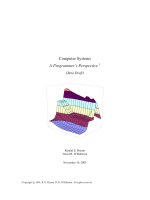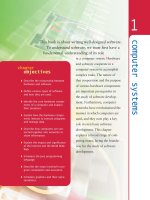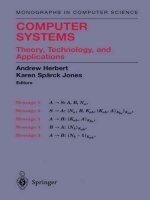Computer systems architecture assignment brief updated
Bạn đang xem bản rút gọn của tài liệu. Xem và tải ngay bản đầy đủ của tài liệu tại đây (173.45 KB, 7 trang )
ASSIGNMENT BRIEF
Qualification
BTEC Level 5 HND Computing and Systems Development
Unit number and
title
Unit 51: Computer Systems Architecture
Assignment issued
Assignment due
Assessor name
Assignment title
Computer Systems
Aim of the
assignment
This coursework is designed in the form of set questions and design
scenario. The tasks are divided into four sections, with section
compromising several questions. The coursework should be submitted as
one document in a report format.
Specific
requirements
(see Appendix for
assessment criteria
and grade
descriptors)
Task 1 (P1, P2, P3, M1)
You’ve been asked by the FPT Academy International to produce a digital
PDF leaflet that will help newcomers to computing understand the
building blocks of computers and how they work.
The booklet should be illustrated with supporting imagery that is
relevant to the topic.
For P1, your tasks are:
●
Explain what is meant by ‘DECIMAL’ and ‘HEXADECIMAL’.
●
Show how to convert decimal number ‘55’ to binary. (Include all
steps)
Hint:
/>ber_conversion.htm
●
Show how to convert binary number ‘10100001’ to decimal.
(Include all steps).
Hint:
FRM03_Assignment brief_14.11.2012
Page 1
/>ber_conversion.htm
●
Show how to convert binary number ‘10001111’ to hexadecimal.
(Include all steps).
Hint:
/>ber_conversion.htm
●
Explain why hexadecimal is a very useful number system,
especially compared to binary.
Hint: Chapter 3. Page 32 – Hexadecimal Notation
●
Show how to add two binary numbers together, give example.
(Include all steps).
Hint:
/>math.htm
●
Show how to convert hexadecimal number ‘A6C’ to decimal.
(Include all steps).
Hint:
/>ber_conversion.htm
●
Show how to store the decimal negative number ‘-35’ using the
two’s complement method. (Include all steps).
●
Show how to convert decimal floating point 4.125 to binary
Hint: Textbook: 3.12 Signed integer
●
Show how to store a floating point number using Binary (Include
all steps).
Hint:
1. />2. />ml
3.Textbook: 3.15 Floating Points
For P2, and P3, your tasks are:
●
Explain what ASCII is.
FRM03_Assignment brief_14.11.2012
Page 2
Hint: Textbook 3.8 Character set
●
Explain how we can convert alphanumeric characters into binary
that allow us to send messages.
Hint: Use ASCII Table
Task 2 (P4)
For P4, your tasks are:
●
Show truth tables of these logic gates: AND, OR, NOT, NAND, XOR
Hint: only show the truth table.
●
Find results for the following logical expression (T: is true, and F:
is false)
Expression
Result
(T AND F) NOR (T XOR F)
(NOT T) XOR (T NAND F)
(T NAND T) OR (NOT T)
(T AND F) AND (T OR F)
Task 3 (P5, P6, P7, M2 and D1)
Being impressed with your explanations of the number systems and bits
and bytes, the British Computer Society has asked you to describe the
following:
A computer has the following key components:
●
A CPU consisting of a control unit, arithmetic & logical unit and a
system clock.
●
Memory.
●
Interfaces
●
Buses
For P5, draw a diagram of how the key components are connected to
each other, with explanations of what each of the components does.
FRM03_Assignment brief_14.11.2012
Page 3
Hint: => just briefly describe
their functionalities
For P6, Explain different types of memory (registers, cache, RAM and
Flash) that can be attached to a processor. Explain what each one is;
explain their performance, storage permanence and cost.
Hint: => go deep into Register,
Cache, RAM, Flash separately in details
For M2, Describe with diagrams where these types of memory are used
in the system. Explain why they are chosen to be used where they are.
Explain the DIFFERENCES between the four types of memory you have
written about.
For D1, draw a diagram showing how memory, storage and I/O devices
are connected to the CPU by the system (or data) bus, address bus and
control bus. Describe the function of each bus.
For P7
Describe how polling can be used to query and work with the printer.
Hint: See prepared slide for chapter 15
Also describe how processor and peripherals communicate using
interrupt mechanism.
Hint: See prepared slide for chapter 15
Which of these two is the most efficient and why?
Hint: See prepared slide for chapter 15
Task 4 (P8, P9, M3 and D2)
You now have an understanding of the basic building blocks of a
computer and how a computer is organised. The BCS would like you to
run some basic CPU classes for school-children including the basic
programming of a CPU.
For P8, in a written document, compare a CISC processor with a RISC
processor, what they are and the advantages and disadvantages of each.
Hint: Please see the prepared slide for this in Chapter 5
FRM03_Assignment brief_14.11.2012
Page 4
For P9, illustrate the use of the different processor registers in the fetchexecute cycle when running a simple subtraction program. You should
be sure to state which registers are being used in the program.
Hint: do an exercise similar to this:
/>metic_instructions.htm
You can try to code online (without needing to install development
environment) from here:
/>For M3, create a low-level program which includes decision making and
branching. Produce listings of the program(s), together with a statement
from the tutor confirming that the program is valid.
For D2, Research bit sizes of current address and data buses and explain
the effect these have on performance and complexity of a processor.
1. You should write this assignment in the essay style, although a formal
essay structure will not be required.
Student guidelines
2. You should use tables, diagrams and figures where appropriate and be
sure to give sources of information.
3. You should include a list of references to all cited sources using the
Harvard referencing system.
4. You should use font Calibri size 12 with 1.5 spacing for your report.
Submission
requirements
Besides the soft copy, students are expected to submit hard copy of the
report
FRM03_Assignment brief_14.11.2012
Page 5
APPENDIX 1: ASSESSMENT CRITERIA AND GRADE DESCRIPTORS
Merit grade:
Merit descriptors
Indicative
characteristics
Evidence
Assessor
(Task number, comments/feedba
other)
ck
M1 explain, using
examples, how
floating point
numbers can be
represented in
binary
Task: 1
M2 compare the
roles played by
different types of
memory
Task: 3
M3 create a lowlevel program
which includes
decision making
and branching.
Task: 4
Achieve
d
(Yes/No)
Internal
verifier
comment
s
Achieve
d
(Yes/No)
Internal
verifier
comment
s
Distinction grade:
Distinction
descriptors
Indicative
characteristics
D1 explain how
the processor is
physically
connected to
FRM03_Assignment brief_14.11.2012
Evidence
(Task number,
other)
Assessor
comments/feedba
ck
Task: 3
Page 6
memory and
input/output (I/O)
devices using the
system buses
D2 explain how
the width of the
data bus and
address bus affect
processor
performance and
complexity.
Task 4
This brief has been verified as being fit for purpose
Internal
Verifier 1
Signature
Dat
e
Internal
Verifier 2
Signature
Dat
e
FRM03_Assignment brief_14.11.2012
Page 7









